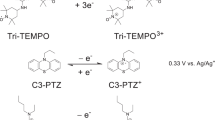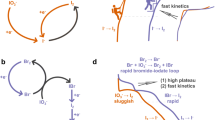Abstract
The electrochemical behaviour of a range of halide and titanium halide redox couple combinations has been evaluated for potential application in redox flow cells employing common elements in both half-cells. Cyclic voltammetry and cell cycling measurements were employed to establish the reversibility of the redox couples and the expected cell voltage and performance in a redox flow cell. An all iodine cell was found to be impractical due to the formation of an insoluble iodine deposit in the cell that caused cell blockage. A titanium polyhalide cell that uses a solution of TiCl4 in HBr/HCl supporting electrolyte in both half-cells was, however, shown to produce an open circuit voltage of 0.9 V and high coulombic efficiencies. Although the voltage efficiency of the cell was low, improvements in cell design may reduce ohmic losses allowing much higher energy efficiencies to be achieved. This cell is equivalent to the vanadium bromide cell that employs a vanadium bromide solution in both half-cells. The lower price of titanium, however, opens the possibility of a significant cost benefit for the titanium polyhalide redox flow cell.
















Similar content being viewed by others
References
Skyllas-Kazacos M, Robins, R (1986) All-vanadium redox battery, US Pat. 4786567
Skyllas-Kazacos M, Rychcik M, Robins R, Fane A, Green M (1986) J Electrochem Soc 133:1057
Skyllas-Kazacos M, Grossmith F (1987) J Electrochem Soc 134:2950
Rychcik M, Skyllas-Kazacos M (1988) J Power Sources 22:59
Sum E, Skyllas-Kazacos M (1985) J Power Sources 15:179
Sum E, Rychcik M, Skyllas-Kazacos M (1985) J Power Sources 16:85
Zhong S, Skyllas-Kazacos M (1992) J Power Sources 39:1
Skyllas-Kazaocs M, Rychcik M (1987) J Power Sources 19:45
Kazacos M, Cheng M, Skyllas-Kazacos M (1990) J Appl Electrochem 20:463
Skyllas-Kazacos M, Kasherman D, Hong R, Kazacos M (1991) J Power Sources 35:399
Largent R, Skyllas-Kazacos M, Chieng J (1993) Proceedings IEEE, 23rd photovoltaic specialists conference. Louisville, Kentucky
Menictas C, Hong D, Yan Z, Wilson J, Kazacos M, Skyllas-Kazacos M (1994) Proceedings, Electrical Engineering Congress. Sydney, NSW
Skyllas-Kazacos M, Menictas C, Kazacos M (1996) J Electrochem Soc 143:L86
Skyllas-Kazacos M, Peng C, Cheng M (1999) Electrochem Solid State Lett 2:121
Kausar N, Howe R, Skyllas-Kazacos M (2001) J. Appl Electrochem 31:1327
Rahman F, Skyllas-Kazacos M (2009) J. Power Sources 189:1212
Skyllas-Kazacos M, Kazacos G, Poon G, Verseema H (2010) Int J Energy Res (Energy storage special issue) 34:182
Skyllas-Kazacos M (2003) J. Power Sources 24:299
Hagedorn N, Thaller L (1980) NASA Report Number: DOE/NASA/1002-80/5, E-383, NASA-TM-81464
Giner J, Cahill K (1980) NASA Report Number: DOE/NASA/0794-80/1, NASA-CR-159738
Wills R, Collins J, Stratton-Campbell D, Low C, Pletcher D, Walsh F (2010) J Appl Electrochem 40:955
Singh P, Jonshagen B (1991) J. Power Sources 35:405
Bartolozzi M (1989) J. Power Sources 27:219
Aylward G, Findlay T (1998) SI chemical data, 4th edn. Wiley, Australia
Mironov V, Lastovkina N (1967) Russ J Phys Chem 8:991
Bard A (1973) The encyclopaedia of the electrochemistry of the elements. Marcel Dekker Inc, New York
Nicholls D (1974) Complexes and first row transition elements. MacMillan Press, London
Wang Y, Lin M, Wan C (1984) J. Power Sources 13:65
Pecsok R (1951) J Am Chem Soc 73:1304
Zolotukhin V, Gnatyshin O (1973) Russ J Inorg Chem 18:1467
Swathirajan S, Bruckenstein S (1980) J Electrochem Soc 112:25
Author information
Authors and Affiliations
Corresponding author
Rights and permissions
About this article
Cite this article
Skyllas-Kazacos, M., Milne, N. Evaluation of iodide and titanium halide redox couple combinations for common electrolyte redox flow cell systems. J Appl Electrochem 41, 1233–1243 (2011). https://doi.org/10.1007/s10800-011-0287-y
Received:
Accepted:
Published:
Issue Date:
DOI: https://doi.org/10.1007/s10800-011-0287-y




